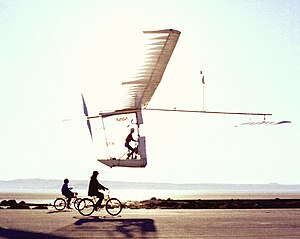Gossamer Albatross
| Gossamer Albatross | |
|---|---|
 |
|
| The Gossamer Albatross II at Dryden Flight Research Center in 1980 | |
| Role | experimental aircraft |
| National origin | United States |
| Manufacturer | AeroVironment |
| Designer | Paul MacCready |
| First flight | 1979 |
| Status | Gossamer Albatross I - Steven F. Udvar-Hazy Center, Virginia, USA Gossamer Albatross II - Museum of Flight in Seattle, Washington, USA |
| Number built | 2 |
| Developed from | Gossamer Condor |
| Developed into | Gossamer Penguin |
The Gossamer Albatross is a human-powered aircraft built by American aeronautical engineer Dr. Paul B. MacCready's company AeroVironment. On June 12, 1979, it completed a successful crossing of the English Channel to win the second £100,000 (£456260 today) Kremer prize.
The aircraft was designed and built by a team led by Paul B. MacCready, a noted American aeronautics engineer, designer, and world soaring champion. Gossamer Albatross was his second human-powered aircraft, the first being the Gossamer Condor, which had won the first Kremer prize on August 23, 1977, by completing a 1-mile (1.6 km)-long figure-eight course. The second Kremer challenge was then announced as a flight across the English Channel recalling Louis Blériot's crossing of 1909.
The aircraft is of "canard" configuration, using a large horizontal stabilizer forward of the wing in a manner similar to the Wright brothers' successful Wright Flyer aircraft and powered using pedals to drive a large, two-bladed propeller. The Gossamer Albatross was constructed using a carbon fiber frame, with the ribs of the wings made with expanded polystyrene; the entire structure was then wrapped in a thin, transparent plastic (mylar PET film). The empty mass of the structure was only 71 lb (32 kg), although the gross mass for the Channel flight was almost 220 lb (100 kg). To maintain the craft in the air, it was designed with very long, tapering wings (high aspect ratio), like those of a glider, allowing the flight to be undertaken with a minimum of power. In still air, the required power was on the order of 300 W (0.40 hp), though even mild turbulence made this figure rise rapidly.
...
Wikipedia
